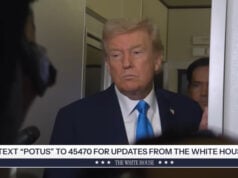
by Mitch Perry, Florida Phoenix
Forecast accuracy for major storms and hurricanes have improved dramatically in recent years, but this capacity is being seriously compromised by proposed budget cuts to the National Oceanic Atmospheric Administration (NOAA) by the Trump administration, a group of weather experts said Wednesday.
The Trump administration last week released its proposed NOAA budget for fiscal year 2026. The plan would close a dozen government research labs, including the Atlantic Oceanographic and Meteorological Laboratory in Miami which includes NOAA’s Hurricane Research Division and the Geophysical Fluid Dynamics Laboratory, which developed most of the improvement in hurricane forecast models.

Dr. Robert Atlas is former director of the Atlantic Oceanographic and Meteorological Laboratory (AOML). He said that lab performs various functions critical to hurricane forecasting, such as hurricane-hunter flights for NOAA; processing Doppler radar data; innovating aerial drones; as well as launching ocean gliders that provide additional measures that help with intensity forecasting.
“The research that goes on at AOML is crucial to maintaining and improving the hurricane model forecast accuracy,” he said during a Zoom conference organized by South Florida Democratic U.S. Rep. Debbie Wasserman Schultz.
Atlas said that AOML had created the HAFS (Hurricane Analysis and Forecast System) model that NOAA uses, and that “all of the improvements that we want to make to that model to increase accuracy even further and to extend the lead time on hurricane warnings and forecasts would not occur if AOML is eliminated.”
Loss of accuracy
Atlas produced a graphic showing constant improvements in the accuracy of hurricane intensity forecasting at NOAA over the years. Shutting down AOML would result in a 20%-40% loss of accuracy, he said, which would leave a billion-dollar impact on the country’s economy, as well as the potential loss of lives.
“Almost certainly by next year, some of the most important intensity models would fall out of service, degrading NHC’s intensity forecasts,” said James Franklin, former branch chief of the Hurricane Specialist Unit at the National Hurricane Center (NHC).
“The websites that provide forecasters with crucial satellite analysis would break. Intensity estimates for storms outside of aircraft range would be degraded, and the formation forecasts for disturbances would likely become less accurate.”
In the long term, Franklin said, track forecasts would continue to improve. He wasn’t as optimistic about the intensity forecast, however. “They would likely stagnate or even regress,” he said.
In addition to the proposed future cuts, the One Big Beautiful Bill Act signed on July 4 by President Trump includes $200 million in cuts to NOAA’s weather forecasting and public alert programs.
And Wasserman Schultz noted that $400 million allocated by Congress last December for hurricane-hunting aircraft and related expenses has already been rescinded by the Trump administration.
Cuts already enacted
Separate from the proposed cuts to NOAA are reduced staffing levels within the National Weather Service (NWS) that has been taking place ever since the Trump administration took office in January. Buyouts and early retirements offered to federal government workers through the Department of Government Efficiency (DOGE) led to the NWS losing 600 of its approximately 4,200 staff. That’s according to Tom Fahy, legislative director of the National Weather Service Employees Organization union, as reported by the BBC.
That’s had an effect already on weather forecasting. The Washington Post reported that for the month ending on May 26, 17% of all U.S. balloon launches that should have occurred had not, mostly because of NOAA staffing losses.
NOAA can do what our local and state governments simply cannot do — they use satellites, radar, aircraft, they track storms, and they issue watches and warnings coordinating with FEMA and our local officials. – U.S. Rep. Lois Frankel
Palm Beach County Democratic U.S. Rep Lois Frankel served as mayor of West Palm Beach back in the aughts. She recounted how her city endured four major hurricanes during her tenure, adding that no lives were lost because the city had several days to prepare due to advanced warning from NOAA.
“NOAA can do what our local and state governments simply cannot do — they use satellites, radar, aircraft, they track storms, and they issue watches and warnings coordinating with FEMA and our local officials,” she said. “Because of those warnings, we were able to evacuate people early from the high-risk areas.”
She added that without that agency’s information, “we would have been flying blind.”
To illustrate the importance of accurate forecasting, Atlas said that when he first moved to South Florida he went to the Florida Keys and asked everyone he and his wife met whether they would evacuate if a Category 5 hurricane was forecast to hit the region, and every person said “no.”
“What was needed was the confidence in our hurricane forecasts,” he said. “And that’s what we’ve worked so hard for in NOAA research. Improving the accuracy means that people don’t get over-warned anywhere near as much. We want to increase it even further, so that people will take necessary actions and that people will evacuate. But the confidence levels increase tremendously as a result of the hurricane research. We don’t want to lose that by having our accuracy decrease.”
Florida Phoenix is part of States Newsroom, a nonprofit news network supported by grants and a coalition of donors as a 501c(3) public charity. Florida Phoenix maintains editorial independence. Contact Editor Michael Moline for questions: info@floridaphoenix.com.
Disclaimer
The information contained in South Florida Reporter is for general information purposes only.
The South Florida Reporter assumes no responsibility for errors or omissions in the contents of the Service.
In no event shall the South Florida Reporter be liable for any special, direct, indirect, consequential, or incidental damages or any damages whatsoever, whether in an action of contract, negligence or other tort, arising out of or in connection with the use of the Service or the contents of the Service. The Company reserves the right to make additions, deletions, or modifications to the contents of the Service at any time without prior notice.
The Company does not warrant that the Service is free of viruses or other harmful components












